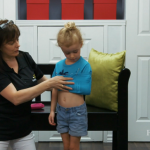

- 14 October 2020
- |
- Andrée Bouchard
Of all the preparations for the Halloween party, the search for a costume is undoubtedly the most arduous task, because dressing up is much more than putting on a costume.
When children dress up, they metamorphose into the person they want to be. The shy boy suddenly adopts the reckless attitude of the hero he personifies, and the little girl behaves like the princess in her favorite movie. The laser sword fights villains and the magic wand transforms the world to suit his whims.
Dressing up can be more than just a game, it can also be a salutary process. For a child who has been bullied, disguises can mask fragility and, for a moment, give the illusion of being stronger, endowed with exceptional powers and free from the dependence of their bully. For some children, Halloween can provide an opportunity to reassure themselves of their weaknesses and take a “mental break”, conducive to the development of resilience.
Why do our little ones love dressing up so much?
Feeling in control
If children love to dress up, it’s first and foremost to feel in control. By taking on the role of policeman/policewoman, king/queen or Superman/Wonderwoman for the duration of a game, they give themselves the power to control a world over which they often have little control. Like the superheroes he loves, he wants to experience courage, strength, fame and perseverance.
Anticipating the future
As they grow, children are transformed. His body lengthens, his physiognomy changes, his sexual identity becomes clearer and his movements more refined. The child needs to tame all these transformations. When a little boy dons a fireman’s costume, he reassures himself that he’s a boy. With her high heels, the little girl tries to imitate her mother. The child may even put on a costume usually worn by the other sex, in an attempt to understand and tame the other’s sexual identity. Like the little boy who wants to wear nail polish or the little girl who wants to be the daddy in the role-play game.
Hiding your weaknesses
Disguises often hide early complexes. Children who feel insecure regain their self-confidence and become adventurers under their Zorro cape. Disguises allow us to invent another life, in which only what we want to show is visible.
The pleasure of being someone else
Superheroes lead enviable double lives. It’s Alice’s laziness that leads her into this completely crazy dream in which she has to confront an evil queen, and Superman is actually hiding a simple journalist. The child in disguise is excited by the idea of fooling others. He plays the strongest and the cleverest. In disguise, the child can break conventions (stay calm, behave) and let himself go screaming, pouncing or borrowing vocabulary that isn’t his own, all with the approval of others.
At what age does the taste for disguises begin?
Babies aren’t interested in dressing up. It’s only around age 3, when role-playing becomes an increasingly important part of a child’s activities, that he or she begins to want to change skin. The first disguises consist of putting on daddy’s boots or mommy’s sunglasses. Then disguises become more sophisticated: the child will want to put on the “ready-to-wear” costumes of the role-play corner (such as the fireman’s costume or the princess dress), and then come up with his or her own disguises, such as the comforter that he transforms into a cape, or the dish of ice cream that he places on his head like a hat as a piece of armor.
Let’s not forget: the primary function of masquerade costume is to have fun! Children should be free to choose the costume they want to wear. If the child decides to wear a “bad guy” costume, for example, it may be because he needs to tame and exorcise his fears. The choice of costume is symbolic: it enables the child to attribute to himself the qualities he needs to develop at a particular time in his life.




